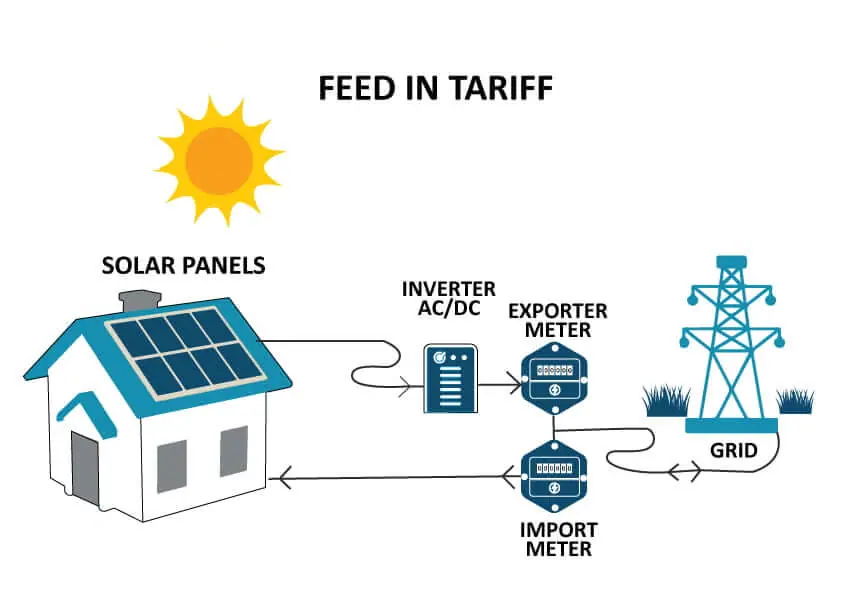Home Feed-In Tariffs How Do Solar Feed-in Tariffs Work?
How Do Solar Feed-in Tariffs Work?
Thinking about installing a solar panel system? If so, solar feed-in tariffs might be hugely beneficial to you.
Solar feed-in tariffs work by enabling people who are producing extra solar energy and are fed back into the main electricity grid to earn money or credits for it.
Normally, you will spend a certain amount of energy for your home use, then you can feed the rest to the grid. Energy companies involved will pay you for that amount of energy.

Table of Contents
ToggleWhat is the solar feed-in tariff?
A solar feed-in tariff is an incentive introduced by utility companies to encourage people to install solar panels but without the need for a battery. By the use of solar feed-in tariffs, solar energy system owners are able to get paid for any excess solar energy that they contribute to the main grid. They can also draw on the grid at night for free as it is offset by the amount they produced earlier in the day.
Feed-in tariffs are offered by all power companies and are applicable for residential homes energy, but not for commercial energy production.
The feed-in tariffs pay the owners in terms of cents per kWh. These rates vary depending on your company and the state you live in.

Who has the best feed-in tariffs?
With 20% of all Australian homes having solar these days, solar feed-in tariffs offered by energy providers is a large factor for homeowners when weighing up which provider to go with.
Some of the leading players in this include Energy Australia, AGL and Origin Energy, but smaller players like Jacana Energy also have some great rates.
On average, Origin Energy has the best feed-in tariffs under their Solar Boost Plus plan which pays 25 c/kWh for people in New South Wales and Victoria.
Energy Australia is another company that offers the highest rates in Queensland at 16.1 c/kWh. For Victoria, the rates are the lowest without the consideration of time standing at 9.9 c/kWh. However, for peak hours, they can go to as high as 29 c/kWh and off-peak they can go to as low as 7.2 c/kWh.
AGL on the other side, and offers 16.3 c/kWh as their highest rate in South Australia. For Queensland, the offer 10.6 c/kWh.
The table below shows the best feed-in tariffs by state and company.
| State | Best Feed-in Tariff (cents/kWh) | Company |
|---|---|---|
| NSW | 25.0 | Origin Energy |
| VIC | 25.0 | Origin Energy |
| QLD | 16.1 | Energy Australia |
| SA | 20.0 | AGL |
| ACT | 20.0 | Origin Energy |
| WA | 20.0 | Origin Energy |
| NT | 23.6 | Jacana Energy |
Is GST payable on money earned?
No. Not unless your total earnings arising from feed-in hit an excess of $75,000 per year. Homeowners are not obligated to pay any GST on income arising from feed-in tariff unless they hit the above figure.
However, the reality is that the figure is way above what any household can ever earn from feeding their extra solar power to the grid. As a result, you should not worry about GST.
As a homeowner, you do not register GST or even remit any GST. It is, however, important to know that this is a different case for business and commercial properties who are supposed to pay GST.
Feed-in tariff rates by state
To enable you to understand the best feed-in tariff companies in your state, here is a list of the top 3 companies per each state with how much they pay on average.
The table shows the first, second and third best companies in each state and their average feed-in rate in cent/kWh.
It will enable you to also figure out which is the best company to work with whenever you are installing a solar system.
| Company | 1st Company (Average rate)- c/kWh | 2nd Company (Average rate)- c/kWh | 3rd Company (Average rate)- c/kWh |
|---|---|---|---|
| NSW | Origin Energy – 16.5 | AGL – 15.55 | Mojo Power – 15.0 |
| VIC | Origin Energy – 17.0 | AGL – 15.65 | DC Power Co – 15.0 |
| QLD | Energy Australia – 16.1 | AGL – 15.3 | DC Power Co – 15.0 |
| SA | AGL – 18.15 | Origin Energy – 16.5 | Powerdirect – 16.3 |
| ACT | Origin Energy – 14.0 | Energy Local – 12.5 | Energy Australia – 12.5 |
| WA | Horizon – 30.0 | Synergy – 7.2 | N/A |
| NT | Jacana Energy – 23.6 | Power Water Corporation – 19.23 | N/A |
When does the solar feed-in tariff end?
Feed-in tariffs are set to end on 31st, December 2030. As they are not a government incentive but something offered by power companies, this will most likely continue after 2030.
Power companies buy the energy from you at a wholesale price and sell it for the retail price to local residents. Although they are only making a few cents per kW of power, they do not have to burn more coal or buy and install their own systems, so it is of a large benefit to them also.
Who pays the tariff?
Your energy provider is the one who pays you for the excess electricity you produce. The government does not pay the tariffs, they only pay the rebate. The process is very clear, once the company gets the energy from you and it is in the main grid, they are able to charge other people for what they use.
As there are several utility companies dealing with the tariffs, you will find there are also different terms and rates for different companies.
With there being a high demand for energy across the country, there are many energy provider companies across Australia. All these companies have different rates and you can compare them to find the best.
FAQs
Yes. Feed-in tariffs change. However, the change in feed-in tariffs is attributed to many variables.
One of the main causes of tariffs change is time. There are companies that have different tariff rates based on time. In most cases, they will pay higher during peak hours and pay low during off-peak.
This is because more people are consuming energy during peak hours while fewer people will consume energy from the main grid during off-peak time.
The cost of electricity on the main grid is another reason why tariffs may change from time to time. Companies depend on the cost of electricity from the main grid for them to earn and pay homeowners supplying the energy.
As a result, fluctuations in the prices of electricity may force the energy companies to change the tariff rates.
Can I change companies whenever I like?
Yes. You are free to change your energy company any time you want. As a result, you want to change your solar energy feed-in traffic company it means you will be changing your electricity provider since it’s all linked together.
The process is always very simple since there is a high competition between energy companies. As a result, all you have to do is contact the company you would like to change to and they will help you initiate the process.
However, it is important to note that there are certain states that have restrictions on changing electricity companies.
There are a few factors that you have to consider before you change the companies. They include the following.
- Exit charges. Since you are exiting a contract from one electricity company to another. You have to make sure that you understand all the fines or exit fees that are attached to ending the contract.
- New feed-in tariff rates. If you want to change companies for the sake of tariffs then the rates should be your concern. Make sure that you consider the new company’s rates to make sure they benefit you.
- Customer incentives. Many companies will come up with different types of incentives to deal with the competition of customers and attract more. You can consider these factors to arrive at the most attractive company. Some of them include rewards, bill credits, and discounts.
Table of Contents
Toggle




